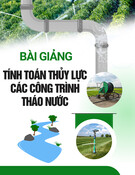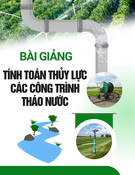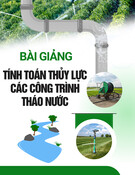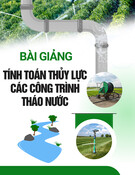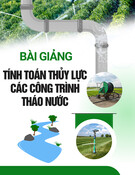
Tuyển tập Hội nghị Khoa học thường niên năm 2015. ISBN: 978-604-82-1710-5
xxxii
INTERNATIONAL DAM SAFETY PRACTICE
AND HOW THIS APPLIES IN VIETNAM
Peter Amos1
1 Managing Director, Damwatch Engineering Ltd, Wellington, New Zealand
Abstract
Dam Safety Practice refers to the safe operation and management of dams and their reservoirs for
all stages of the dam’s lifecycle that follow construction and commissioning. Considering the safety
of dams once they commence operation is necessary to protect people, property and the environment
from the potentially catastrophic impacts of a dam failure or uncontrolled release from the
impounded reservoir.
Dam Safety Practice has evolved throughout the world since the 1970’s, partly in response to a
number of high profile incidents and disasters. The well-known Teton dam failure in the USA in
1976 resulted in the introduction of dam safety legislation and the Safety Evaluation of Existing
Dams (SEED) program and practices. These forced recognition that regular maintenance and
constant vigilance is required to ensure safe operation of a dam.
Worldwide there is a general effort to align dam safety practice with recommendations of the
International Commission on Large dams (ICOLD). Many countries, including Viet Nam, have
laws (decrees) and regulations requiring dam owners to have dam safety programmes. The laws
and regulations provide minimum requirements which are usually well covered by national Dam
Safety Guidelines, commonly published by national dam safety organisations. Key differences
from country to country tend to reflect their specific legislative and natural hazard context. The
Dam Safety Management Systems published in well considered dam safety guidelines apply the
principles espoused by ICOLD in their publications.
In Viet Nam, the Dam and Downstream Community Safety Initiative (DDCSI) is a methodology
for dam owners and managers to identify and assess the natural hazards and risks associated with
their dams and develop options to mitigate these risks. This should assist in prioritising repairs and
upgrades based on risk to the population and damage to economic assets downstream of the dam. It
can also be applied at the feasibility stage to inform dam design, operation & maintenance, and
emergency preparedness.
The VNCOLD Dam Safety Manual systematically addresses the safety of dams from design,
construction, management, maintenance, periodic verification of dam safety level. It also addresses
responsibilities allocated to involved organisations and individuals responsible for dams in
accordance with Decree 72 ND-CP.
Introduction
Viet Nam has one of the largest dam
systems in the world, comprising more than
6,000 dams, with 750 of those classified as
medium and large dams (VNCOLD, 2012;
Dam, et al., 20121,2). With topography of
1 Dam, T.T., Burritt, R.L., Pisaniello, J.D. (2012).
Adequacy of policy and practices for small
agricultural dam safety accountability and
assurance in Vietnam. Agricultural Water
Management, Volume 112, Pages 63–74.
mountainous highlands in the west and
densely populated coastal plains, a large
percentage of the Vietnamese population is
at risk from dam failure flooding. Poorly
constructed dams have failed and errors in
operation of dams (including cascade
2 VNCOLD. (2012). Dam Safety Manual. A report
prepared by the Vietnam National Committee on
Large Dams (VNCOLD) for the Ministy of
Agriculture and Rural Development (MARD).
Date: Dec 2012.

Tuyển tập Hội nghị Khoa học thường niên năm 2015. ISBN: 978-604-82-1710-5
xxxiii
operations) have also lead to serious and
unexpected flooding. Past dam failures and
operational release incidents have taken
hundreds of lives and caused substantial
economic losses and damage to the
environment.
Dam Safety Practice refers to the safe
operation and management of dams and their
reservoirs for all stages of the dam’s lifecycle
that follow construction and commissioning.
Considering the safety of dams once they
commence operation is necessary to protect
people, property and the environment from
the potentially catastrophic impacts of a dam
failure or unexpected release from the
impounded reservoir.
Design of dams is covered by design
standards and guidelines in many countries.
While the specifics may vary from country to
country, the fundamental principles for the
design of each type of dam has a great deal of
commonality across the world.
However the design of each dam is based
on the standards and practices current at the
time the dam was designed. Over time
design practices improve with advances in
engineering knowledge and lessons from dam
incidents and failures.
The standard of construction depends on
many factors including regulation, the level
of oversight, the quality control and quality
assurance during construction.
Operational dam safety is a more recent
addition to dam practice. Dam Safety
Practice has evolved throughout the world
since the 1970’s, partly in response to a
number of high profile incidents and
disasters. Prior to the Teton Dam failure in
the USA in 1976, many countries did not
have regulations or guidelines for operational
dam safety. Incidents such as the Teton dam
failure forced recognition that regular
maintenance and constant vigilance (through
a structured dam safety monitoring
programme) is essential to ensure safe
operation of a dam. In the USA, the Teton
Dam failure resulted in the introduction of
dam safety legislation and the Safety
Evaluation of Existing Dams (SEED)
program. The primary emphasis of the
SEED program was to perform site
evaluations and quickly identify dams that
posed an increased threat to the public, and to
quickly complete the related analyses in
order to expedite corrective action decisions
and safeguard the public and associated
resources3.
Viet Nam has regulated dam safety with
Decree No. 72/2007/NC-CP which was
issued by the Government of Viet Nam in
May 2007. This decree was revised in 2013
with Government approval anticipated soon.
Decree 72 sets out specific requirements for
dam safety management which has many
parallels with key principles and
requirements published in dam safety
guidelines from a number of countries..
International Organsiations leading Dam
Safety Standards and Practices
The International Commission on Large
Dams (ICOLD) is a non-governmental
organisation formed in 1935, to lead the
profession in setting standards and guidelines
to ensure that dams are built and operated
safely, efficiently, economically, and are
environmentally sustainable and socially
equitable4. There are currently 95 member
countries of ICOLD. Each country has voting
rights and is eligible to participate in Technical
Committees that coordinate the production of
Bulletins describing commonly agreed practice
examples and publishing case studies.
Each member country is represented at
ICOLD by its own National Body. These
National Bodies tend to also be non-
governmental organisations with membership
from dam owners, design organisations,
construction bodies and educational institutes.
Each country is responsible for its own
regulation and national standards. Standards
documents usually define those practice
3 http://www.usbr.gov/ssle/damsafety/
4 http://www.icold-
cigb.org/GB/ICOLD/mission_icold.asp

Tuyển tập Hội nghị Khoa học thường niên năm 2015. ISBN: 978-604-82-1710-5
xxxiv
requirements made mandatory by law or
regulation. Guideline documents differ in
that they may describe recommended good
practice in the country which is not covered
by law. Key differences from country to
country tend to reflect their specific
legislative and natural hazard context. This
may include exposure to seismic events and
typhoons, and operation and maintnenace
tasks to be carried out e.g. pre-rainy season.
National Bodies help to disseminate
ICOLD Bulletins in their country and in
many cases write Guidelines of practice
applicable in their home country. Some
national bodies may recommend that their
country follow Guidelines prepared by other
countries. Examples of Guidelines often
referred to by other national bodies are those
from the Canadian Dam Association (CDA),
the Australian National Committee on Large
Dams (ANCOLD) and the New Zealand
Society of Large Dams (NZSOLD). These
may be general Guidelines covering accepted
national practice for all dam safety related
matters5,6 or Guidelines on specific topics7.
In some countries guidelines or manuals on
dam safety related matters may be produced by
Government agencies, regulators or self-
regulating dam owners and engineering
organisations. Examples of these are USA
organisations such as the Federal Energy
Regulating Commission (FERC), United States
Bureau of Reclamation (USBR) and the United
States Army Corps of Engineers (USACE).
Many of the documents produced by these
organisations are design practice manuals
that describe the most advanced technical
knowledge.
International non-Government organisations
(NGO’s) such as the World Bank may also
have policies and procedures that must be
5 CDA 2007: Dam Safety Guidelines, Canadian
Dam Association
6 NZSOLD 2015: New Zealand Dam Safety
Guidelines, New Zealand Society of Large Dams
7 ANCOLD 2003: Risk Management Guidelines,
Australian National Committee on Large Dams
followed if they are to be involved in national
or regional projects8. These NGO’s may also
fund initiatives to write Guidelines and
practice documents for countries.
Generally technical Guidelines and
manuals that recommend good practice are
more expansive than the specific laws and
regulations relating to dam safety.
Compliance reporting is likely to address
only a small part of what comprises a good
dam safety management programme.
The Vietnamese National Committee on
Large Dams (VNCOLD) represents Viet
Nam at ICOLD. Vietnamese representatives
have held elected office at ICOLD. This
participation provides an important link to
other countries and allows Viet Nam to
understand the relationship between local
practice and international practice.
VNCOLD through a World Bank project has
published a Dam Safety Manual9.
Principles of Dam Safety
ICOLD has published principles that should
apply to the safety of all dams regardless of
location or size. The ICOLD Principles from
Bulletin 15410 are listed as follows:
1 “The fundamental dam safety objective
is to protect people, property and the
environment from harmful effects of mis-
operation or failure of dams and reservoirs.”
The stored volume of water needs to be
retained and all flows through and around the
dam controlled within specified limits. “Mis-
operation” involves any departure from safe
operation of any part of the dam or its safety
critical systems.
2 “The prime responsibility for
operational integrity and safety of a dam
should rest with the Dam Owner.”
8 World Bank 2001: Dam Safeguard Policies, BP
4.37, Annex A - Dam Safety Reports
9 VNCOLD 2012: Dam Safety Manual, Vietnam
Water Resources Assistant Project (VWRAP), World
Bank Loan No. Cr3880-VN, December 2012
10 ICOLD 2010: Bulletin 154 Dam Safety
Management: Operational Phase of the Dam Life
Cycle, International Commission on Large Dams

Tuyển tập Hội nghị Khoa học thường niên năm 2015. ISBN: 978-604-82-1710-5
xxxv
Sometimes a government institution or
agency is responsible for the safety of the
dam and the public, either directly or through
oversight over the safety management
activities of the bodies that operate the dam.
3 “The legal and governmental framework
for all industrial activities, including
operation of dams, provides the overarching
structures for operational integrity and safety
assurance.”
Dam safety guidelines and manuals will
always need to recognise laws and regulations.
4 “Effective leadership and management
for operational integrity and safety should be
established and sustained over the life cycle of
the dam.”
Dam managers are responsible for the
physical lifetime of the dam.
5 “Protection should seek to achieve a
balance across competing objectives to provide
the highest level of operational integrity and
safety that can reasonably be achieved.”
The safety measures applied to dams are
considered balanced if they provide the
highest level of safety to people, property and
the environment that can reasonably be
achieved throughout the physical lifetime of
the dam, without unduly limiting its use.
6 “Measures for controlling risks from
dams should ensure that no individual bears
an unacceptable risk of harm, and that the
risks to society do not exceed the risk
tolerance levels of society.”
7 “In order to secure the societal value,
dams and reservoirs must be sustained in
the long term. To ensure sustainability of
dams, all reasonably practicable efforts
should be made to prevent and mitigate
failures and accidents.”
• Future generations should be considered
in dam safety decisions.
• Safety standards apply not only to local
populations but also to populations remote
from the dam and reservoir.
8 “Appropriate arrangements should be
made for emergency preparedness and
response for dam failures and accidents.”
Those responsible need to establish in
advance arrangements for emergency
preparedness and response to a dam breach
emergency. Plans may be needed at local,
regional and national levels, and where agreed
between countries, at the international level.
Implementing the Principles of Dam
Safety
To achieve the highest standards of safety
that can reasonably be achieved, measures
must be taken to:
• Eliminate or reduce predictable hazards
or establishment of controls over them to the
extent that is practicable. Natural hazards
such as floods earthquakes and landslides
need to be identified, quantified and
understood in order to assess whether
mitigation measures at a dam are adequate.
• Eliminate or reduce failure modes, if
practicable and if judged to be reasonable in
terms of cost and risk reduction benefit.
Potential Failure Modes Analysis (PFMA) is
a tool that informs dam safety experts of the
wide range of potentially catastrophic ways
that the dam could fail. The form and nature
of the resulting breach is an important
parameter in the consequential flood that
discharges from the dam. The PFMA also
helps identify priorities for rehabilitation as
well as improvements to operation,
maintenance and surveillance of a dam.
PFMA is adopted internationally as a dam
safety evaluation tool.11,12
• Justify that the capacity of the system and
its components exceeds the demands by
sufficiently large margins to provide assurance
11 FERC. (2005). Engineering Guidelines for the
Evaluation of Hydropower Projects: Chapter 14 -
Dam Safety Performance Monitoring Program.
Federal Energy Regulatory Commission.
12 EA. (2013). Guide to risk assessment for
reservoir safety management. United Kingdom
Environment Agency.

Tuyển tập Hội nghị Khoa học thường niên năm 2015. ISBN: 978-604-82-1710-5
xxxvi
of protection. This involves engineering
assessment of the dam against the most up-to-
date technical knowledge and standards.
• Prevent loss of control over the stored
volume and the spillway and other
discharges. Control the release of damaging
discharges downstream of the dam through
controls that are part of the normal, pre-
determined operating procedures of the dam.
• Provide the capability to intervene and
avert failure in the unlikely event that a failure
mode initiates. Identify the development of
unsatisfactory conditions through visual and
instrument monitoring. Trained operators and
engineers with resources to intervene are
important resources.
• Mitigate the consequences of events if
they were to occur through emergency
planning and/or on-site accident
management. Knowledge of the flooded area
through dam break and flood modelling
identifies the population and economic area
at risk from flooding. Procedures for
effective evacuation to prevent loss of life
given dam failure need to be provided.
Structural protections (such as flood dykes or
levees) to be constructed if appropriate.
• Provide funding mechanisms for the
training of operators and engineers, physical
upgrades of dams and compensation of the
community affected by a failure.
World Bank Policies for Dam Safety
Management
The World Bank Operational Policy BP4.37
requires Dam Safety Reports as follows:
1 Plan for construction supervision and
quality assurance. This report covers the
organization, staffing levels, procedures,
equipment, and qualifications for supervision
of the construction of a new dam or of
remedial work on an existing dam.
2 Instrumentation plan. This is a detailed
plan for the installation of instruments to
monitor and record dam behaviour and the
related hydro-meteorological, structural, and
seismic factors.
3 Operation and maintenance (O&M)
plan. This detailed plan covers organizational
structure, staffing, technical expertise, and
training required; equipment and facilities
needed to operate and maintain the dam;
O&M procedures; and arrangements for
funding O&M, including long-term
maintenance and safety inspections.
4 Emergency preparedness plan. This plan
specifies the roles of responsible parties
when dam failure is considered imminent, or
when expected operational flow release
threatens downstream life, property, or
economic operations that depend on river
flow levels emergency forces and equipment.
Dam Safety Management Systems
International dam safety bulletins and
guidelines such as those published by
ICOLD, CDA and NZSOLD recommend that
dam owners utilise a Dam Safety
Management System (DSMS) to provide a
structured framework for the safe operation
and management of its dams and reservoirs.
ICOLD Bulletin 15413 states that a DSMS
should consist of systematic and
comprehensive processes in order to ensure
that the dam safety risks are properly managed
and that all aspects of safety management are
integrated or aligned with the organization’s
overall management structure.
The DSMS provides a formal organized
process by which safety of the dam is
ensured and maintained throughout its
lifetime, from the conceptual phase, through
design, construction and operational stage to
decommissioning. This is achieved by
development of a series of policies,
procedures, directives and instructions.
Figure 1 illustrates an example of the
structure and contents of a DSMS14.
13 ICOLD 2010: Bulletin 154 Dam Safety
Management: Operational Phase of the Dam Life
Cycle, International Commission on Large Dams
14 NZSOLD 2015: New Zealand Dam Safety
Guidelines, New Zealand Society of Large Dams



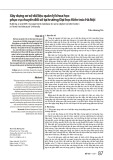
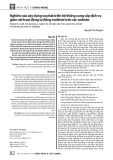

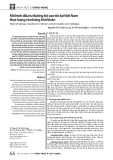
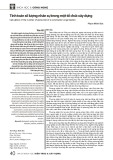

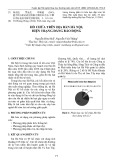
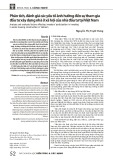







![Bài giảng Quản lý vận hành và bảo trì công trình xây dựng [chuẩn nhất]](https://cdn.tailieu.vn/images/document/thumbnail/2025/20251006/agonars97/135x160/30881759736164.jpg)


